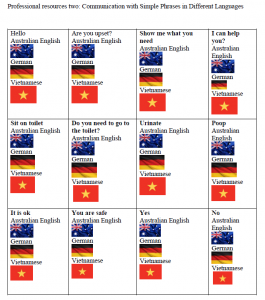21 Communicating with simple phrases
Claudia Aston
I need words in community languages to comfort children when they’re upset or for toilet training. Can someone make a resource with simple, useful phrases that we could use with children? 85% of our children are Vietnamese but resources in any of Australia’s community languages would be great!
Simple Phrases in community languages to comfort children when they are upset or for toilet training.

Images in resource used under Creative Commons Zero licence
Rationale
This multicultural professional learning resource is used by selecting a simple recorded phase to comfort children when they are upset or for toilet training. It is an interactive digital communication word document to access phrases in different languages. English, German and Vietnamese languages are opened through pressing the link of a phrase. The document is set out as a table with each box including the phrase written in English and audio recording of the phrases in English, German and Vietnamese.
With the increase in multilingualism in Australian society it is important to support bilingualism or multilingualism in scaffolding teaching and learning experiences (Hyde, Carpenter, & Dole, 2017). The two-way communication resource will allow the child to have the opportunity to interact with the document to communicate his or her needs. Vygotsky’s theory of Language Development focused on social learning through interaction with others (McLeod, 2018). It is the educator’s role to support language development through quality interactions (Webb & Williams, 2018).
The Australian Curriculum recognises learners moving between the existing (first language) and new languages and culture as integral to language learning and a key to developing students’ intercultural understanding (Australian Curriculum, Assessment & Reporting Authority, 2019b). In creating a supportive, respectful language learning environment, the right to practice one’s own culture, language and religion is fostered (United Nations General Assembly, 1989). Language learning is supported by the Early Years Learning Framework (DEEWR, 2009) learning outcome five as children use information and communication technologies to access information, investigate ideas and represent their thinking (DEEWR, 2009, p. 47).

